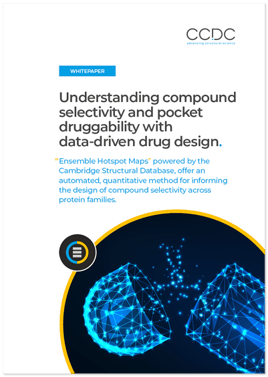Data-driven drug design with "Ensemble Hotspot Maps"
Understanding compound selectivity is vital when designing novel pharmaceuticals. The extent of on- and off-target effects, or potential polypharmacology, informs modifications to develop safe and effective drugs.
In this whitepaper we present a data-driven method which visualizes binding site comparisons across a protein family, to deeply understand selectivity and pocket druggability.

These "Ensemble Hotspot Maps" are derived from peer-reviewed, experimentally-generated data in the Cambridge Structural Database, and automated to rapidly and visually guide target validation and drug design.
In the whitepaper you will learn:
- Use cases: how ensemble hotspot mapping can improve your drug-design.
- Data-driven origin: how ensemble hotspot maps are derived, and how to access the script to run the analysis.
- Pharma industry impacts: how leading pharmatech ExScientia have implemented the approach in their workflows.
- Research impacts: how a University of Cambridge team used fragment hotspot mapping to understand their DNA-PKcs target (as published in Nature)
About us:
The Cambridge Crystallographic Data Centre (CCDC) are world-leading experts in structural chemistry data, software, and knowledge for materials and life sciences research and development.
We enable scientists to learn from collective structural chemistry data: public or proprietary, experimental or predicted. From big pharma to top universities, and new biotech and drug discovery start-ups, thousands of scientists globally use CCDC data and software to advance their science.
